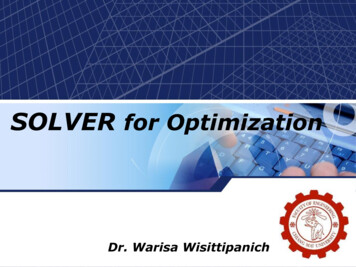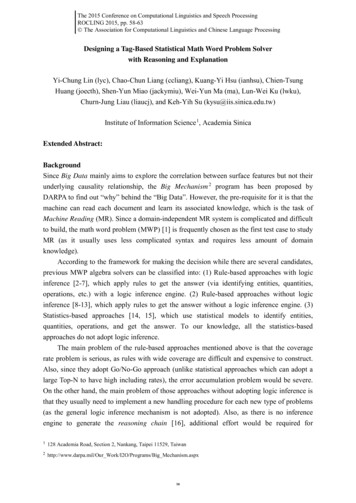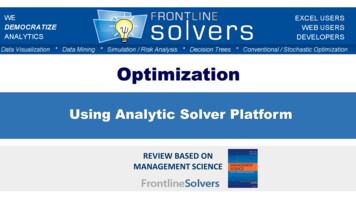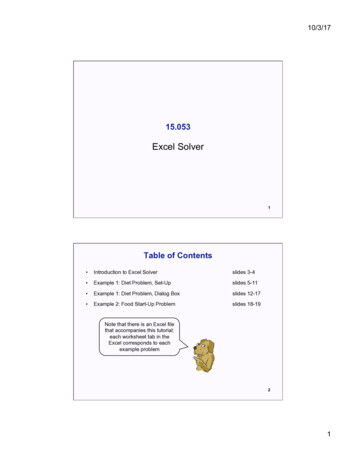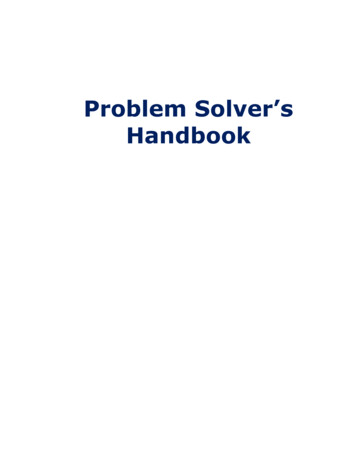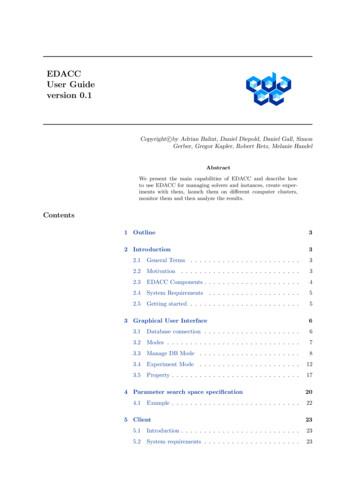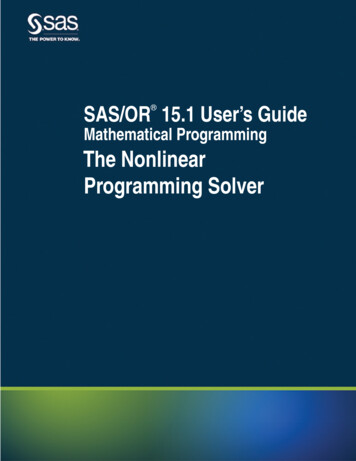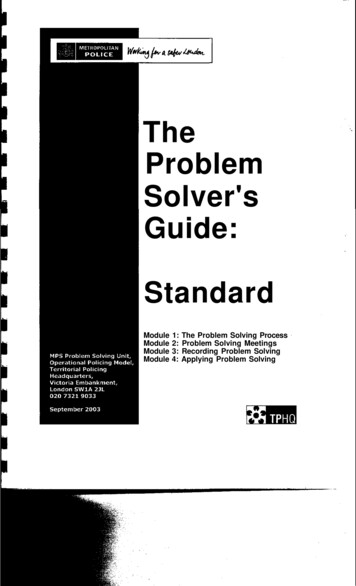
Transcription
Module1:2:3:4:The Problem Solving ProcessProblem Solving MeetingsRecording Problem SolvingApplying Problem Solving
The content was correct at the time of publication.(Document to be next reviewed December 2003)
What is Problem Solving?Michael Stevens, in his book How to be a better Problem Solver, describesProblem Solving as:'. transforming one set of circumstances to another, preferred state.'Problem Solving is a way of improving a situation by degrees. We call this theImpact scale.The Impact scale means:eliminating a problem; orreducing a problem by x%; orreducing the seriousness of a problem; ordealing with a problem more efficiently; orpersuading another organisation to take the lead.Problem Solving in police work has been around for at least twenty years and hasbeen used successfully all over the world. It works by identifying and dealing withthe root causes of a problem instead of repeatedly responding to theconsequences. Police and partners, working together, can use Problem Solving tomanage crime, reduce the number of calls police have to deal with, reducecoilisions and to improve people's quality of life (e.g. by getting rid of abandonedcars, vandalism, graffiti etc.).The Metropolitan Police Service Problem Solving Unit has drawn upon bestpractice around the world to design a simple but effective Problem SolvingProcess (PSP) for you to use. The PSP complies with the National IntelligenceModel (NIM) and forms part of the MPS Operational Policing Model. They havealso designed a practical, easy to complete form (The PSP File or Form 302) thatyou can use to record the Process. The PSP and the PSP File are now being usedby police and partners across London.The Problem Solving Unit is also involved in providing modular training courseswhere participants can learn the skills and techniques needed for effectiveProblem Solving. The courses are suitable for police officers, police support staffand partners. The modular design means that flexible or part-time workers canalso attend.All exercises and discussions are initially based around non police-related topicsso that participants start with a Mevel playing field' of knowledge. The course thendevelops by examining typical problems that affect police and partners. PlainEnglish is used in all handouts and course documents.This book accompanies the course, providing useful advice and information aboutthe principles, procedures and practical application of Problem Solving.We hope you find it useful.In keeping with best practice, the Problem Solving Unit staff are on hand forcoaching, advice and support as you develop your Problem Solving skills andknowledge. Please call if you have any questions.Contact details for the MPS Problem Solving Unit are on Page 36.Page 1 of 38
Module 1 - The Problem Solving Process (PSP)Aims and ObjectivesAims - That the participant: has an overview of the Problem Solving process; and develops the skills that are required to communicate effectively in writing.Objectives - By the end of this module the participant will be able to:1. Identify where the Demand comes from and what it is.2. Identify partners and decision makers.3. Define the precise nature of a Problem.4. Define the Aim using SMART objectives.5. Recognise that there are alternative sources when researching a problem.6. Analyse the results of the research, which will assist in Problem SolvingMeetings.7. Recognise analytical tools and techniques.8. Recognise what a Problem Solving Meeting is.9. Appreciate that all ideas have a value in the Problem Solving Meeting.10. Appreciate the difference between ideas and possible options.11. Appreciate the difference between possible options and a viable intervention.12. Acknowledge the need to evaluate all interventions.13.Acknowledge the need fora review.14. Apply the three elements of the Problem Analysis Triangle to the differentstages of the Problem Solving Process.15. Recognise the importance of well written and well presented letters and reports.16. Recognise the importance of writing in a plain English style.17. Recognise the principles that make a letter more effective.18. Be aware of the six stages of good report writing.Page 3 of 38
The Problem Solving Process (PSP)PurposeThis guide allows you to see all of the different stages on one page. Theword process means "A defined way of working through something."The DemandWhat is the demand and who is making it? What is the significance of the demand?What is the problem? Define the problem.What is your Aim? What do you want to achieve? How will you measure success?Research - What is out there? Who are your partners?VictimOffenderLocationAnalysis - Making sense of your researchVictimOffenderLocationProblem Solving Meeting(s).This is where you, your colleagues, and others with an interest in resolving the problem,can make a contribution. PSMs are used to develop a range of options to tackle theproblem by using the research, analysis and local knowledge.VictimOptions - What can be done?OffenderLocationResponse - What interventions are being put in place?VictimOffenderLocationEvaluate - How well did the individual interventions work?VictimOffenderLocationReview - Has this initiative met the Aim?Page 4 of 38
Exercise AUse this page to record a current work-related problem.DemandProblemAimVPage 5 of 38
The Problem Analysis TriangleLocationWhere is the problem happening?SMART ObjectivesWhen deciding what your Aim wil be, you must remember the Impact Scale(Page I) and think SMART:Specific. Make sure that your objectives'hit the naif on the head'.Measurable. How wilt you know whetheryou've achieved your Aim? Decide oneffective ways to measure success.AAchievable. Set realistic targets.Remember that Problem Solving is ailabout improving a situation (Rememberthe Impact Scale on Page 1). You maynot be able to totally eliminate a problem,Relevant. Are you tackling the symptomsrather than the problem? And does youraim justify the amount of work you andyour partners are putting into It?Time, Set realistic timescales forcompletion of your aim and for periodicreviews along the way.Page 6 of 38
Writing in a plain English styleThe MPS and its partners employ people from a wide range of national, ethnic,religious and educational backgrounds. Some people have recognised medicalconditions that make reading and writing difficult for them. Some have English asa second, or even third, language. If we want to be seen as 'transparent'organisations that have nothing to hide, we must communicate in an open andhonest way. One easy way of doing that is to use plain English.Plain English means writing in a style that suits the broadest possible audience. Itis not'dumbed down' English. Plain English Campaign - the leading UK authorityon plain English - defines it as:1. a clear and concise message, written with the reader in mind and with theright tone of voice.'In other words, your writing should be:CorrectUse the right words, grammar and punctuation. Use activevoice rather than passive voice (The staff met rather than Ameeting was held by the staff.) Use verbs to describeactions, not nouns (We will meet rather than We will have ameeting).ClearAny reasonable person should be able to understand whatyou've written after one reading. Proofread and revise yourwork. If possible, try it out on a sample of your audience.ConciseA lot of people will be reluctant readers. Their first reactionwill be to look at the amount they have to read. Keep itshort but not abrupt. Make your sentences short (Average15-20 words per sentence) and stick to the essentials avoid waffle.ConversationalUse everyday words in an everyday style. Write as if you aresitting opposite a group of your readers. Write the wordsthat you'd use if you were talking to them. Use words like I,Me, You, My, Your etc.ConsiderateThink about your readers' needs before your own. Useeveryday terms and avoid jargon if possible. If you have touse jargon, explain what it means or provide a glossary.The main advantages of plain English are: it is faster to read; andyou get your message across more often, more easily and in a friendlierway.Plain English doesn't change the meaning of your message. It just makes it easyto understand. Banks, insurance companies and solicitors now produce plainEnglish documents without losing meaning. You can do the same.Page 7 of 38
How to write better lettersGeneral rules Decide what you want to say and make a list the points you want toinclude;Arrange your points in a logical order;Use a separate paragraph for each point;Quote any references, contact names, addresses, telephone numbers oremail addresses;Don't waffle and don't tell the reader what they already know.The headerGive the letter a heading so that your reader will know what the letter is about assoon as they open it. Don't use ALL UPPER CASE letters or underline as thismakes things difficult to read. Bold is much better.The contentUse plain English;Use punctuation to help clarity and understanding;Use short, simple sentences;Consider numbering the paragraphs if this will help the reader;Be brief. Long letters don't get read;If you have to include lots of information, consider using an appendix; andIf the letter covers different subjects, consider giving each one a newheading.The toneYour tone will let your reader know what your attitude is toward them. Aim for atone that will achieve the desired result. Don't use ambiguous words and phases.Be appropriate, tactful, helpful, polite, sympathetic and honest.Opening and closingInformal address:Forma! address:'Dear Mr/Mrs/Ms' and end with 'yours sincerely.' (Of course,use of a first name is appropriate if you know the reader.)"Dear Sir/Madam' and end with 'yours faithfully.'ChecklistDoes your first paragraph introduce the subject of your letter?If you're replying to a letter, have you thanked the person for their letter(It is courteous and does not admit liability)?Does your final paragraph summarise the letter and point the way ahead?Have any important facts been left out?Is there too much detail? If so, what? Get rid of the waffle!Having read your letter, will your reader know what they need to do, orwhat you are going to do?Page 8 of 38
Better report writingPlan your report Who is it for?Why do they want it?What do you want to achieve by writing it?Research the topic.Decide on the items you want to include.Group related items together.Get rid of anything irrelevant or repetitive.Structure the report - The 6 PsPurpose - Why are you writing this report?Position - What's the position at the moment?Problem - What's wrong with this position?Possibilities - What options exist to improve the situation?Proposal - Which is the best option and why?Packaging - Will people want to pick up your report?Packaging your reportooooooooUse 1.5 or double line spacing;Use generous margins and indents;Break up large blocks of text with headings and subheadings;Break up long lists with bullet points;Use italics or bold text for emphasis. Avoid underlining and capitals as itmakes reading more difficult for some readers;Use different fonts and font sizes for emphasis;Use graphs, pie charts, diagrams, pictures, clip-art and so on to illustratecertain points; and finallyDon't be too clever! People will quickly see through gimmicks.And don't forget to include .ssvvss svs*sA title page;The name of the author;Acknowledgement of others who helped;A contents page and a summary page;The aim of the report;A verybrief, one-two sentence description of each section;A conclusion or proposal;Key content sections: The 6 Ps;A glossary of any technical terms used;Appendices (for details, tables of figures etc.) if required; andBibliography and references.Copyright 2003 Video Arts LtdPage 9 of 38
Enter the name of your workplace hereEnter the title of the report hereReplace the text in the following sections with your own text.The sections will expand to fit.PurposeWhat is the purpose of the report?Who is it for?Why do they want it?What do you want to achieve with it?PositionWhere are we now?What is happening at present?ProblemWhat is the situation that is causing a problem?You may wish to describe some of the consequences that are occurring alreadybecause of the problem. You could also describe the potential consequencesthat probably will occur in future.PossibilitiesWhat options exist that could improve the current problem?What are the pros and cons of each option?If cost is an issue, details should be given with each option.ProposalWhat appears to be the most appropriate option?Why is it the most appropriate option?What action should be taken?For an electronic copy of this template or the PSP File (Form 302), contact theMPS Problem Solving Team (Details Page 36).Page 10 of 38
Module 2 - Problem Solving MeetingsAims and ObjectivesAim - That the participant can: plan and prepare for a Problem Solving Meeting (PSM) and facilitate and/orparticipate effectivelyObjectives - By the end of this module the participant will be able to:1. Define the purpose of a PSM and when it is appropriate to hold one.2. Identify the difference between formal and informal meetings.3. Identify ways of reducing the need to attend meetings.4. Identify the benefits of networking at meetings.5. Identify the order of meetings.6. Identity ways to direct and reduce the length of a meeting.7. Prepare an open and inclusive agenda.8. Recognise the need to arrange the content in a logical sequence and anticipatewhat is likely to be required.9. Recognise the importance of timings within a meeting.10. Identify the most appropriate location for a meeting.11. Appreciate the need to summarise and record all decisions and who isresponsible for undertaking each Action.12. Identify what constitutes an Action.13. Identify a range of techniques for dealing with difficult people.14. Identify ways to unite, focus and mobilise the group.Page 11 of 38
The Problem Solving MeetingPreparing for a Problem Solving MeetingHere is a short guide to holding successful meetings. Follow the advice and yourProblem Solving Meetings should go smoothly (the rules work for all kinds ofmeetings). The first question you should ask is:Do I actually need a meeting?If all you need to do is assign tasks or share information, hold a quick briefinginstead. In fact, a memo or a few short phone calls may be an even moreeffective use of yours and everybody else's time. Meetings are about participationand shared decision-making. No participation required no meeting required.If I decide J need a meeting, what next?There is a 5 stage plan to organising effective meetings.1.2.3.4.5.PlanInformPrepareStructure and ControlSummarise and Record1. PLANThe purpose of an effective meeting is to meet a set of objectives in the minimumtime to the satisfaction of the participants. So, firstly, you have to plan for yourmeeting by:* being clear why you need a meeting;s being clear what your objectives are; ands listing the topics.2. INFORMs*ss smake sure everyone knows what is being discussed - create an agenda;make it clear why you want a meeting and what you want from it;anticipate what information and who might be needed;select the right participants;select the Chair (if not chairing personally); andensure that everyone can attend.Page 12 of 38
Creating the agendaUse verbs ('doing' words) in your agenda items; Agenda items should always be'active' in order to focus the participants on the task in hand. Remember that ameeting relies on participation and 'doing' something.An agenda item that says:Item 1: Budgets. means nothing in itself and time will be wasted in having to explain what theitem means. It's far more effective to explain the agenda item more fully and touse verbs to show the activity required.Item 1: Discuss the forthcoming annual budget so that heads ofdepartments may submit their applications for extra funding ifrequired.It's significantly longer but, if I were attending the meeting, I'd know preciselywhy I'd been invited and would be able to prepare myself with facts, figures ormaybe even a presentation.What goes on the agenda? Title of meeting. Date, time, venueApologies for absenceMinutes of previous meetingItems to be discussed and decidedMotions related to the aboveReports from sub-committeesContributions from guest speakersDate, time and venue of next meeting.Selecting participantsAlthough it would be most democratic to invite anyone with a vested interest, thisis impractical. Therefore, you must choose representatives for each group ordepartment or organisation where staff have a vested interest. If you have anysay in the matter, choose dynamic people; people known for their good ideas and'make it happen' attitude.Setting a level playing fieldIt is very important to ensure that all participants know why they have beenselected and what the meeting is going to be about. No participant should everfind themselves "treading water' at a meeting because they don't understand thediscussion. A good agenda will forewarn them so that they can get up to speed. Italso saves time and will make the meeting more effective. You don't want tospend five minutes explaining every agenda item for the benefit of uninformedparticipants.3. PREPAREs Prepare a logical sequence of items on the agenda; ands Base the time allowed for each item on importance, not urgency.Page 13 of 38
4. STRUCTURE AND CONTROLThe ChairYou will often be the Chair at Problem Solving Meetings. Whoever is Chair needsthree essential skills. They are the abilities to:Unite the group:The meeting won't be successful if everyone is pulling in different directions.Assure everyone that they all have the opportunity to participate.Ensure that people contribute properly and participate actively.Let the participants let off steam - simmering and sulking lead to aggression.Be impartial and stick to facts.Focus the group:Getting off the point wastes valuable time.Stay alert and keep your hand on the wheel.Test comprehension at every opportunity.Paraphrase complex statements, check back with the person who first madethe statement and keep effective minutes (you or, better still, by a secretary).Mobilise the group:Don't allow anyone to criticise any idea (their own or another's), no matterhow silly it seems, until all ideas have been put forward.Encourage diversity - Let people be adventurous, even outrageous, in theideas they put forward.Give the same initial status to all contributions and record them in order tostimulate more ideas.Protect the weak from bullying behaviour and stronger personalities.Exhaust the supply of ideas before evaluating, comparing and makingdecisions.Look at the positive elements of all ideas. Make every idea look as strong as itcan before examining pitfalls or weaknesses.Reward the participants for their hard work and contributions.Check around the group for consensus and comprehension before finalisingdecisions - Give the participants ownership.If decisions reached mean that work needs to be assigned to individuals,choose the person most likely to succeed in that task. If it is not the personwho suggested the idea, ask them to assist the person as an 'advisor'.Page 14 of 38
How your meeting should go1. Introduce the subject of your meeting - Explain why the meeting is necessary.2. Explain the current position and what you want to achieve or change.3. Plan the discussion - Involve all group members, encourage contributions.4. Participation - Draw out and examine current situation, peoples' experience,ideas. What would participants suggest?5. Solution(s) / actions6. Chair - Summarise, Clarify and Agree options / actions.7. Conclude meeting - Thank participants, confirm what actions will be taken, bywhom and when?8. Arrange date of next meeting.5. SUMMARISE AND RECORD Summarise ail decisions and record them straight away, along with thename of the person responsible for any action(s).s Create a set of minutes and distribute them to participants for theiragreement.What goes in the Minutes?If you organised the Problem Solving Meeting, the minutes are yourresponsibility. They can be very brief, but they should include these facts: The time and date of the meeting, where it was held, and who chaired it. The names of all present and apologies for absence. All agenda items (and other items) discussed and all decisions reached. Ifaction was agreed on, record the name of the person responsible for theassignment. The main arguments leading to decisions. You can, if you wish, attributeall suggestions, points and arguments to the people who made them.However, this is liable to provoke endless quibbling or qualifying whenpeople see their names attached to their alleged statements. It is oftenbetter to record the various relevant points without specifying who madethem. The time at which the meeting ended (important, because it may besignificant later to know whether the discussion lasted 15 minutes or 6hours). The date, time and place of the next Problem Solving Meeting.Copyright 2003 Video Arts LtdPage 15 of 38
Module 3 - Recording Problem SolvingAims and ObjectivesAim - That the participant can:* document all stages of the Problem Solving Process: and plan, prepare and deliver effective presentations.Objectives - By the end of this module the participant will be able to:1. Appreciate the need to record Problem Solving.2. Identify the form used to record Problem solving, the PSP File/Form 302.I3 Identify how to record problem solving and comply with the requirements of theNational Intelligence Model (NIM).4. Identify how to record sensitive information.5. Identify the different sections of the PSP file/Form 302.6. Describe the importance of preparation when delivering a successful presentation.7. Describe the importance of having a structured presentation.8. State the 'POP' structure that could be used for a presentation when there issufficient time to deliver it.9State the Vital Messaging structure that could be used for a presentation whenthere is not sufficient time to deliver it.,0. Recognise the need to adapt a presentation to different audiences.Page 17 of 38
PSP Rfe [FOOT 302)Insert Company logoURN: PSP/i/PROBLEM SOLVING PROCESS - PSPAdministrationDepattment/Unit/Team,Person Laadsng.NameLocal Ref (Pay no., etc)IDeputy;Date started:1I last update:Demand1.12What is the demand?1.2Where k the demand cooling from?1.3What is the significance of the demand?Problem2,12.23What is the problem?Who are our partners?Mm3 "4What dc you want to achieve?AuthorisationDepartment'UratTeam ManagerHave checks been made to ensure that no one else ss working an this problem?Have appropriate background checks been completed?I am the line manager and IV doT" do net gj?iutthe need for action al this time,My reasons are:1 recommend an assessment every;Name:Department:Problem Solving Advisor's Comments (if one has been appointed}:5Researching the Problem5 1How is the prcblerr* currency being handled?5,2Who shares your age 18 of 38Date:Telephone Numbers)
BAnalysissi profileProblem Solving Meeting (si8Options8.33location )Response9.1Vicfim(s)9.2Offenders)Risk assessment for each intervention:Risk assessment for each ers)Review11.1Has 5 met the aim?11.2 If yes, Hsw has t met the asm?11.3 If no, why hasn't it m* t the aim?12Closureons by the L;ns Manager ciasing this file:UXVUl :i S JCI Hi it/f r j l J i J l Bm Soh ng Senior Manages (Lea :
How to complete the PSP File/Form 302The Demand is not necessarily theproblem. The demand is what thecomplainant asks the ProblemSolver to deal with. Clearly identifythe source(s) of the demand e.g.residents, local businesses, NPs,etc. Record their contact details forfuture reference.The significance of the demand isimportant. Abandoned cars are notas urgent a problem as abandonedcars in which children cart get hurtor kitted.The unique reference number for this file.(Number/Dept/Year e.g. PSP/12/CX/2003 orPSP/33/Wardens/2003)/,*PROBLEM SOLVING PROCESS - PSPDon't put sensitive informationon the PSP File/302 as they areopen to public scrutiny.Who eise is involved or affected bythis issue? Partners may haveuseful information. Their roie mightmake them suitable for inclusion inthe response(s) or to assist withfuture funding. Record their detailsand contact numbers.Write a dear description of TheProblem. If you are writing morethan two sentences, check to see ifyou have more than one problem.There should only ever be oneproblem per PSP File/302.Enter The Aim here. What do youwant to achieve? What is thedesired goat? Remember theImpact Scale (Page 1)? Thesetting of a clear Aim is vitallyimportant because it focuses anddrives ail efforts and activitiesYour Aim should use SMART/Objectives (Specific - Measurable -/Achievable - Relevant - Time). Se Page 6./TYou should submit the form to aline manager for their approval(Authorisation), They will decidewhether or not they support the Fileand record their reasons. Theyshould also set an evaluation periode.g. every week, every month, etc.Both Police and Partners can appoint Problem Solving Advisors tooversee the Problem Solving Process. The Advisor is able to check that theProblem and the Aim have been correctly defined. He/She is also abte toadvise and suggest interventions based upon their knowledge of previousand current Problem Solving research and activities.Enter details of ail Research undertaken by everyone involved in theprocess. Your role is to co-ordinate research gathering. It does not entailyou carrying out all the research. You will engage the help of the partnersand other departments who hold information.You need to research your problem. Has any work been done before, whodid it (Collect their contact details, as they may be able to offer help andadvice) and what worked and what failed? You wii! need to collect as muchinformation about who or *«hat is causing the problem, who or what is beingaffected and exactly when and where is it taking place.Exchanging information with partners is not a problem provided that thenecessary protocols are fotiowed.Page 20 of 38
Analysis means making sense of theinformation you've gathered. You oncomplete the analysis yourself.Alternatively, an analyst workingwithin your or a partner organisationcould do it (depending on the type ofproblem).Under Victim you should recorduseful information such as: Wherehad the victim come from? Were theylocal? Had they just used publictransport? Are all the robbery victimsthe same? etc.«Analysis1?frofci*m Soring :«« *&*»(*}O Mfat .8§2rr.8iQ&smssr )-,,s - ,Offender is where you record thework undertaken by yourself or, ifpolice, the Intelligence unit. You willneed to inciude any relevant crimereport references, custody reports,housing reports, education reports,etc.Under Location you should recordthe features of the area orenvironment that contribute to theproblem. These may includeenvironmental surveys,CrimePrevention Officers1 reports or securityworks by the local authority, etc.The Problem Solving Meeting iswhere all interested parties gettogether and work through theproblems using all the research,analysis and their own experience andexpertise to develop and discussoptions. Several PSP Meetings maytake place tackling Victim, Offenderand Location separately (as identifiedpartners may be different for each).Enter details of all Meetings on thePSP File/302, Record details ofpersons present, their name, contactdetails and the organisations) theyrepresent. These details will proveuseful for those developing theProblem Solving Process in the future.You must take minutes at eachsession and record on the PSPFile/302 where the minutes can befound.Response, These are the options that will be applied, short,medium and long term. Identify who or which organisations canimplement the responses and their time frame.A risk assessment has to be completed for each intervention.You will need, to evaluate your responses throughout the life of theproblem (Your fine manager may have suggested review dates e.g.monthly, three-monthly etc.). Should your action(s) be stopped,changed or maintained?This is a final Review, when your action is complete.Record all Options that were putforward during the PSP Meetings inthe relevant sections. Identify whichoptions are relevant and those thatare not. Explain the reasons why.Remember to consider theimplications of the Human Rights Act2000. Have you achieved your aim?If yes, how can you tell?If not, why not?It is a common mistake to think that just because a solution worked inone place it can be applied elsewhere. The circumstances that made Itsuccessful may not be present. However, if it could be applied elsewhere,record the fact and why.LClosure. This is where the PSP File is 'signed off by a supervisor because there is nothing more that can be doneuniess there are significant changes in the nature of the problem or it arises again.Page 21 of 38
The PSP File - Police ProcedureThe PSP File - otherwise known as Form 302 - is a Microsoft Word document withexpandable boxes that allows Problem Solving to be recorded in a logical and clear way.The diagrams on pages 20-21 show you how to complete the boxes.The next few pages contain additional notes about the PSP File that relate to MetropolitanPolice procedures.Obtaining the formThe PSP File/Form 302 can be downloaded from the MPS intranet Forms Site.Administration Enter your personal details and those of the deputy officer. This will normally bethe unit sergeant.Ensure that you always put the date in the Last Update section so that the mostrecent version can be identified and worked on.You don't need to add the URN (unique reference number) to the form at this time.DemandEnter any sensitive details on CRIMINT and cros
Problem Solving is a way of improving a situation by degrees. We call this the Impact scale. The Impact scale means: eliminating a problem; or reducing a problem by x%; or reducing the seriousness of a problem; or dealing with a problem more efficiently; or persuading another organisation to take the lead. Problem Solving in police work has .

